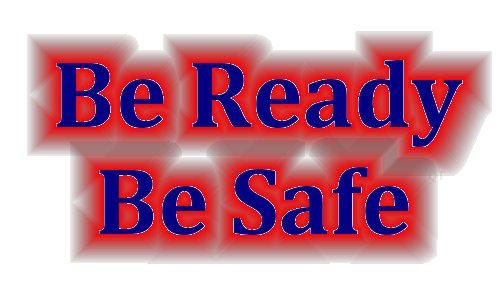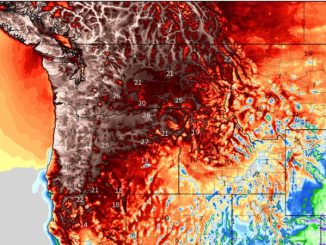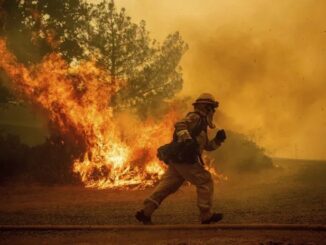Ready, Set, Go – Evacuation Levels
LEVEL 1 – A Level 1 Evacuation means “BE READY” for potential evacuation
Residents should be aware of the danger that exists in their area, monitor emergency services websites, sign up for NIXLE (emergency information texts and emails) and local outlets for information. This is the time for preparation and precautionary movement of persons with special needs, mobile property and under certain circumstances pets and livestock. If conditions worsen, emergency services personnel may contact you via door to door contacts, NIXLE (emergency notifications) or phone calls directly to your landlines (if applicable)
LEVEL 2 – A Level 2 Evacuation means “BE SET” to evacuate
You must prepare to leave at a moment’s notice. This level indicates there is significant danger to your area, and residents should either voluntarily relocate to a shelter or with family or friends outside of the affected area. If you choose to remain you will need to be ready to evacuate at a moment’s notice. Residents MAY have time to gather necessary items, but doing so is at their own risk. This may be the only notice that you receive. Emergency services cannot guarantee that they will be able to notify you in conditions rapidly deteriorate. Area media services will be asked to broadcast periodic updates.
LEVEL 3 – A Level 3 Evacuation means “GO” Evacuate “NOW”
Leave Immediately ! Danger to your area is current or imminent, and you should evacuate immediately. If you choose to ignore this advisement, you must understand that emergency services may not be available to assist you further. DO NOT delay leaving to gather any belongings or make effort to protect your home. This will be the last notice you receive.
Entry to evacuated areas may be denied until conditions are safe. Area radio, TV Stations, social media and NIXLE will be providing periodic updates for residents to monitor.
Residents must be aware that in rapidly changing situations an evacuation might not proceed by stages. In an extremely dynamic situation there may not be time for a Level 1 or Level 2 evacuation. The immediate need may dictate the activation of an immediate Level 3 evacuation.
Evacuate Immediately if told to do so by Emergency Responders! Evacuate when you become aware of an approaching wildfire! Evacuate if you feel threatened!
Some things you can do before Level 3 Evacuations are ordered.
· Stay tuned to your radio, television, social media sites, and sign up for NIXLE notifications. Make sure to follow the instructions of local emergency officials.
· Park your vehicle facing outward, loaded and have your keys on you at all times. During the emergency always have at least a 1/2 tank of fuel in your vehicle. If you have to leave a vehicle behind, leave it facing outward with windows rolled up, unlocked and away for your residence or outbuildings.
· Locate all family members and pets to prepare for evacuation
· Prepare livestock for transportation
· Wear protective clothing and sturdy shoes. Wear 100% cotton clothing to include long sleeve shirt, long pants and hat. Have eye protection to guard from flying embers and a dry bandana, wash rag or handkerchief to cover your mouth and nose.
· Place your evacuation kit and important valuables in your vehicle.
· If available place an aluminum ladder outside of your residence at a corner of your residence for firefighters to quickly access your roof
· Seal attic and ground vents with pre-cut plywood or commercial seals.
· Place a connected garden hose and buckets full of water around the outside of your residence.
· If you have available place all shovels, rakes, hoes etc., near your residence for use by firefighters.
· Move propane BBQ appliances away from all structures.
· Turn off all fuel tanks to include propane, oil etc.
· Turn off all pilot lights.
· Remove all combustible materials such as lawn and patio furniture, doormats, outside decorations, children’s toys, trash cans etc away from your residence or place them in the water filled pool.
· Remove combustible window furnishings from around all windows in your residence.
· Leave your lights on within the residence.
· Leave your windows closed ,your heating and air conditioning off and fireplace dampers closed.
· Check on your neighbors to ensure they are preparing to evacuate as well.
· Leave a note on your front door advising emergency responders and or your neighbors that you have evacuated along with your evacuation destination and contact information for you.
Example of Emergency Supply Kits:
· Three (3)day supply of non-perishable food and three (3)gallons of water per person.
· Know at least two evacuation routes.
· Prescriptions or special medications.
· Medically needed devices.
· Change of clothing.
· Extra eyeglasses or contact lenses.
· All available car keys, credit cards, cash, monetary items.
· First aid kit.
· Flashlight.
· Battery powered radio and extra batteries.
· Sanitation supplies.
· All important documents (vehicle titles, insurance information, birth certificates, passports, marriage license etc.)
· If you have a pet don’t forget food and water for them.
· If time allows, easily carried valuables.
· Family photos and other irreplaceable items.
· Personal computer information on hard drives and disks.
· Chargers for cell phones, laptops, etc.
· Pictures of your property inside and out, to include your garage and attic if possible before you leave the property.
· If you have items that you are having to leave due to time restrictions make sure you have written down all serial numbers, makes and models and that you have pictures of each item.
· Check on your neighbors to make sure they are preparing to leave as well.
BEFORE WILDFIRE THREATENS
Evacuation Plan
Print your plan and put it on your refrigerator, or put a copy in your disaster supplies kit. Make sure everyone in your family knows where your kit is. Also keep in mind that many of these principles apply to all disaster types.
Get a map of your area and make sure everyone in your family understands the ways in and out of your neighborhood.
Assign tasks to each family member for what to do during Level 1 (Ready), Level 2 (Set), Level 3 (GO!) evacuations. Print this checklist and post it on your refrigerator.
Designate a meeting place – this could be a friend or family members’ house, or an evacuation shelter.
Choose an out – of – the – area contact person to relay information about your welfare to family and friends and to keep your phone lines open.
House Preparation
Make sure house numbers are visible from the street.
Make sure driveways are wide enough for fire trucks to enter (10-12 feet wide).
Prepare your defensible space.
Disaster Supplies Kit
Keep kits supplied and ready at all times in your home and in your vehicle. Kits should include, at the minimum, food and water for each family member for 3 days, battery operated radio, flashlight and extra batteries, first aid kit, and an extra set of sturdy clothing for each family member. Don’t forget medications, as necessary.
Assemble pet kits and keep them in your home and vehicle. Include food, water, leashes, carriers, and medications.
Assemble special documents, like birth certificates, social security cards, legal documents, phone contact lists, family photos, household inventory, and any portable valuables into easily-moved containers that can be loaded into a vehicle quickly and easily.

Please support our coverage of your rights. Donate here: Paypal.me/RedoubtNews







Pray for all these people, their families, their property, homes, and livestock. Nothing is scarier than running from wildfires, especially if you have kids and livestock. God be with these people to help and protect them all!